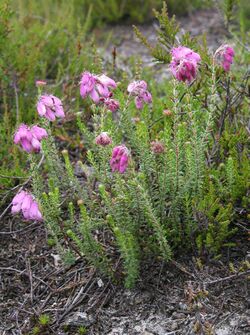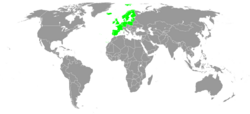Biology:Erica tetralix
| Erica tetralix | |
|---|---|

| |
| Scientific classification | |
| Kingdom: | Plantae |
| Clade: | Tracheophytes |
| Clade: | Angiosperms |
| Clade: | Eudicots |
| Clade: | Asterids |
| Order: | Ericales |
| Family: | Ericaceae |
| Genus: | Erica |
| Species: | E. tetralix
|
| Binomial name | |
| Erica tetralix | |

| |
Erica tetralix, the cross-leaved heath, is a species of flowering plant in the family Ericaceae, native to western Europe.
Description
It is a perennial subshrub with glandular leaves in whorls of four (whence the name). Appearing in summer and autumn, small pink bell-shaped flowers droop in compact clusters at the ends of the shoots.
Similar species
Related species E. cinerea has glabrous leaves in whorls of three. Calluna vulgaris has much smaller and scale-like leaves in opposite and decussate pairs.[1]
Taxonomy
The sticky, adhesive glands on leaves, sepals and other parts of the plant prompted Charles Darwin to suggest that this species might be a protocarnivorous plant, but little, if any, research has been done on this.[2]
Distribution and habitat
E. tetralix is native to western Europe from southern Portugal to central Norway , as well as a number of boggy regions further from the coast in Central Europe such as Austria and Switzerland . It has also been introduced to parts of North America.
E. tetralix can become a dominant part of the flora in bogs, wet heaths, and damp coniferous woodland.[3]
Ecology
A species of Trialeurodes whitefly discovered in 1971 was named T. ericae for the plant, due to its frequent association with it.[4]
Cultivation
In cultivation, like other heathers, E. tetralix requires an acidic soil, as it is a calcifuge. Numerous cultivars have been developed for garden use, of which E. tetralix f. alba 'Alba Mollis'[5] (a white-flowered variety) and E. tetralix f. stellata 'Pink Star'[6] have gained the Royal Horticultural Society's Award of Garden Merit.[7]
References
- ↑ Clive Stace (2010) New Flora of the British Isles, 3rd edition. Cambridge University Press.
- ↑ Darwin, Charles. (1875). Insectivorous Plants. London: J. Murray.
- ↑ http://linnaeus.nrm.se/flora/di/erica/erica/erictetv.jpg. [bare URL image file]
- ↑ Bink-Moenen, Rosita M. (1976). "A new whitefly of Eric tetralix". Entomologische Berichten. 36. Amsterdam. pp. 17. https://www.biodiversitylibrary.org/page/57850816#page/29/mode/1up.
- ↑ "Erica tetralix f. alba 'Alba Mollis'". Royal Horticultural Society. https://www.rhs.org.uk/Plants/94077/Erica-tetralix-f-alba-Alba-Mollis/Details.
- ↑ "Erica tetralix f. stellata 'Pink Star'". RHS. https://www.rhs.org.uk/Plants/97870/Erica-tetralix-f-stellata-Pink-Star/Details.
- ↑ "AGM Plants - Ornamental". Royal Horticultural Society. July 2017. p. 36. https://www.rhs.org.uk/plants/pdfs/agm-lists/agm-ornamentals.pdf.
External links
Wikidata ☰ Q1421121 entry
 |

